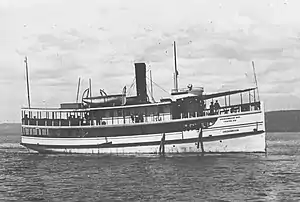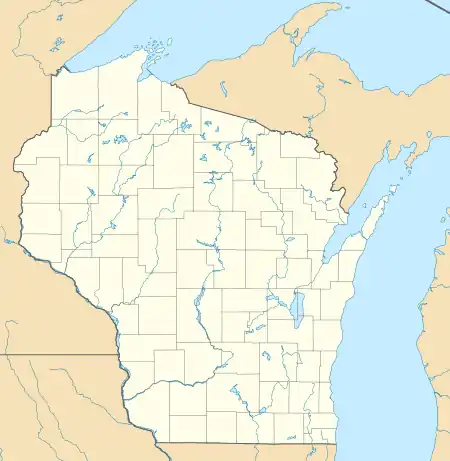Robert C. Pringle (tug)
Robert C. Pringle, originally named Chequamegon, was a wooden-hulled American tugboat that sank without loss of life on Lake Michigan, near Sheboygan, Wisconsin on June 19, 1922 after striking an obstruction (possibly floating driftwood).
 Robert C. Pringle as Chequamegon, c. 1903 | |
| History | |
|---|---|
| Name: | Robert C. Pringle |
| Operator: | Pringle Barge Line Company, Mentor, Ohio[1] |
| Port of registry: | Fairport, Ohio[2] |
| Builder: | Manitowoc Shipbuilding & Dry Dock Company, Manitowoc, Wisconsin[3] |
| Yard number: | 1 |
| Launched: | May 9, 1903[3] |
| In service: | June 23, 1903[4] |
| Out of service: | June 19, 1922[5] |
| Identification: | Registry number US 127764[5] |
| Fate: | Sank after striking an obstruction[5] |
| General characteristics | |
| Class and type: | Tugboat |
| Tonnage: | |
| Length: | 101 ft (30.8 m)[5] |
| Beam: | 22.33 ft (6.8 m)[5] |
| Depth: | 9.50 ft (2.9 m)[5] |
| Installed power: | |
| Propulsion: | 1 × 7.5 ft (2.3 m) fixed pitch propeller[4] |
Robert C. Pringle (tug) Shipwreck | |
 | |
| Location | 8 miles (13 km) southeast of Sheboygan, Wisconsin |
| Coordinates | 43°41′30.48″N 87°33′17.52″W |
| Built | 1903 |
| Architectural style | Manitowoc Shipbuilding & Dry Dock Company |
| NRHP reference No. | 100005902 |
| Added to NRHP | December 14, 2020[7] |
Chequamegon was built in 1903 in Manitowoc, Wisconsin by the Manitowoc Shipbuilding & Dry Dock Company. She was built for the newly formed Chequamegon Bay Transportation Company of Ashland, Wisconsin, under whom she hauled freight between Aslhand, Bayfield, Washburn and Madeline Island. Between 1904 and 1918, she was sold multiple times, and was renamed Pere Marquette 7 in 1911. In 1918, Pere Marquette 7 was sold to the Pringle Barge Line of Cleveland, Ohio. She was converted to a tug and was renamed Robert C. Pringle.
On June 18, 1922 Robert C. Pringle was towing the wooden bulk freighter Venezuela from Milwaukee to Sandusky, Ohio, where the Venezuela was scheduled to receive extensive repairs. At about 2:00 A.M. on the following day, the vessels were passing Sheboygan, Robert C. Pringle struck an obstruction (some contemporary reports state a piece of driftwood) and began began taking on water fast. Despite her pumps being in operation, the water eventually extinguished her boilers, forcing her crew to abandon her and row to Venezuela. All of the crewmen were delivered safely to Manitowoc.
Robert C. Pringle's remarkably intact wreck was discovered in 2008 by Steve Radovan. It was subject to a thorough archaeological survey by the Wisconsin Historical Society in the summer of 2019. The wreck of Robert C. Pringle was listed on the National Register of Historic Places on December 14, 2020.
History

Design and construction
Robert C. Pringle (Official number 127764)[5] was built as Chequamegon in 1903, by the Manitowoc Shipbuilding & Dry Dock Company on the banks of the Manitowoc River in Manitowoc, Wisconsin.[3] The first vessel built by the newly established shipyard, she was launched at 3:06 P.M. on May 9, 1903 as hull number #1.[3] Chequamegon's wooden hull was 101 feet (30.8 m) in length, 22.33 feet (6.8 m) (or 22.4 feet, 6.8 m[8]) wide, and 9.50 feet (2.90 m) (or 9.6 feet, 2.9 m[8]) deep.[5] She had a gross register tonnage of 141 tons, and a net register tonnage of 112 tons.[5][8]
Chequamegon was powered by a 500-horsepower (370 kW) rpm triple expansion steam engine, the cylinders of which had bores of 12 inches (30.5 cm), 19 inches (48.3 cm) and 32 inches (81.3 cm), and a stroke of 20 inches (50.8 cm).[4][6] A single 10.5-by-11-foot (3.2 by 3.4 m) 175 pounds per square inch (1,210 kPa) Scotch marine boiler supplied the engine with steam. The engine was manufactured in Montague, Michigan[9] by the Montague Iron Works, while her boiler was manufactured in Ferrysburg, Michigan by the Johnson Brothers Company. A 7.5-foot (2.3 m) fixed pitch propeller propelled her to a top speed of 18 miles per hour (15.6 kn; 29.0 km/h).[4][6]
Chequamegon had two decks, a single mast, and a round stern.[8] No expense was spared in fitting her out.[10] Her cabins contained oak woodwork, and upholstered furniture throughout.[4]
Service history
Chequamegon was built for the Chequamegon Bay Transportation Company of Ashland, Wisconsin,[4] who intended to use her as an excursion vessel between Ashland, Wisconsin, Bayfield, Wisconsin, Washburn, Wisconsin and Madeline Island. She she was issued a temporary enrollment on June 13, 1903 in Milwaukee, Wisconsin, and on June 23, she was issued a permanent enrollment at Marquette, Michigan.[6][11] In the middle of September, her trips to Madeline Island were discontinued, and she was moved to Duluth, Minnesota where she was fitted with a new propeller in order to improve her speed. She made excursions around the Apostle Islands on September 26 and 27, and October 10 and 11.[11] Scheduled to be moved to Milwaukee in 1904, she made her final trip was made on May 21, 1904, between Ashland and Washburn; she arrived in Milwaukee the day after her final trip. In June of that same year, Chequamegon began transporting passengers from Milwaukee to Pabst's Whitefish Bay Resort. She was chartered by the Benton Transit Company of Benton Harbor, Michigan in August 1904, and had bulwarks fitted to her lower deck.[12] During this time, she ran between Benton Harbor and Milwaukee. Chequamegon's propeller was damaged on September 12, 1904 while she was inbound for Milwaukee.[12] When Louis A. Cartier, president of the Chequamegon Bay Transportation Company moved to Ludington, Michigan, she briefly hauled fruit towards the end of the shipping season, from Benton Harbor and St. Joseph, Michigan to Milwaukee. Chequamegon resumed her trips for Pabst's Whitefish Bay Resort, briefly engaging in the fruit trade in September 1906.[13] On April 22, 1907, Chequamegon was sold to R. Floyd Clinch of Chicago, Illinois;[6] her home port was changed to Chicago.[14] Chequamegon was transferred to Clinch's Traverse Bay Transportation Company in 1908.[6][14] In that same year, she was taken to Sturgeon Bay, Wisconsin, where she received a new 9.5 feet (2.9 m) propeller, built by H.G. Trout & Company of Buffalo, New York. After receiving some additional repairs, she returned to her Charlevoix, Michigan - Traverse City, Michigan route. On August 18, 1909, Chequamegon's cook, Sanford M. Silver drowned after falling overboard.[15]
In 1911, Chequamegon was sold to the Pere Marquette Line of Steamers. Her name was changed to Pere Marquette 7 on January 30.[5][6][15] She ran between Chicago, Waukegan, Illinois, Milwaukee, Kenosha, Wisconsin and Port Washington, Wisconsin, carrying freight.[16] In April 1914, Pere Marquette 7 was overhauled and repainted in Sturgeon Bay.[17] In 1918, Pere Marquette 7 was sold to the Pringle Barge Line Company of Mentor, Ohio, and was renamed Robert C. Pringle. She was converted to a tugboat in Sandusky, Ohio, and had her home port changed to Fairport, Ohio.[1][2] She towed barges in the Lake Erie coal trade.[6] Briefly during her career, she was renamed Henry R. Heath.[2]
Final voyage
The Pringle Barge Line Company acquired the wooden bulk freighter Venezuela in 1922. As Venezuela required significant repairs, Robert C. Pringle was dispatched to Milwaukee, Wisconsin, in order to tow Venezuela to Sandusky, Ohio, where the repair were scheduled to be made. The vessels departed Milwaukee at around midnight on June 18, with Robert C. Pringle under the command of Captain Martin Oglesbee.[18] At around 2:00 A.M. on the following day, as Robert C. Pringle and Venezuela were passing Sheboygan, Wisconsin, Robert C. Pringle struck an obstruction (possibly floating driftwood), and began taking on water fast.[18] She sank in ten minutes, with all her crew being rescued by Venezuela, who dropped her crew off in Milwaukee.[19][20] Venezuela proceeded to sail to Sandusky under her own steam. After she sank, there was speculation that Robert C. Pringle sank because a weakness in her hull due to her age.[19]
Robert C. Pringle wreck
The wreck of Robert C. Pringle was discovered in 300 feet (91.4 m) of water by Steve Radovan in 2008.[19][21] Radovan had been searching for her since the 1970s, locating the wrecks of the schooners Floretta and Home in the process.[22][23] Her wreck is upright and completely intact. Her pilothouse, along with the glass in four of its windows remain in place.[21][24] The captain's cabin, located behind the pilothouse is also intact.[25] Robert C. Pringle's triple expansion engine still has gold lettering on it.[26]In 2019, maritime archaeologists from the Wisconsin Historical Society partnered with Tom Crossmon's Crossmon Consulting LLC to conduct a thorough archaeological survey of the wreck.[21][27]
References
- Wisconsin Historical Society (2020), p. 30.
- Wisconsin Historical Society (2020), p. 31.
- Wisconsin Historical Society (2020), p. 20.
- Wisconsin Historical Society (2020), p. 22.
- Bowling Green State University (2010).
- Alpena County George N. Fletcher Public Library (2020).
- National Park Service (2020).
- Wisconsin Historical Society (2020), p. 21.
- Alpena County George N. Fletcher Public Library (2021).
- Wisconsin Historical Society (2020), p. 21-22.
- Wisconsin Historical Society (2020), p. 23.
- Wisconsin Historical Society (2020), p. 24.
- Wisconsin Historical Society (2020), p. 25.
- Wisconsin Historical Society (2020), p. 26.
- Wisconsin Historical Society (2020), p. 27.
- Wisconsin Historical Society (2020), p. 28.
- Wisconsin Historical Society (2020), p. 29.
- Wisconsin Historical Society (2020), p. 32.
- Wisconsin Historical Society (2020), p. 33.
- Wisconsin State Journal (1922).
- Wisconsin Shipwrecks (2021).
- The Associated Press (2008).
- La Crosse Tribune (2008).
- Wisconsin Historical Society (2020), p. 37.
- Wisconsin Historical Society (2020), p. 39.
- Pioneer Press (2008).
- Wisconsin Historical Society (2020), p. 34.
Sources
- Alpena County George N. Fletcher Public Library (2020). "Chequamegon (1903, Excursion Vessel)". Alpena, Michigan: Alpena County George N. Fletcher Public Library. Retrieved January 6, 2021.
- Alpena County George N. Fletcher Public Library (2021). "Hunter (1877, Propeller)". Alpena, Michigan: Alpena County George N. Fletcher Public Library. Retrieved January 6, 2021.
- Bowling Green State University (2010). "Chequamegon". Bowling Green, Ohio: Bowling Green State University. Retrieved January 6, 2021.
- La Crosse Tribune (2008). "Divers find shipwreck in Lake Michigan off Sheboygan coast". La Crosse, Wisconsin: La Crosse Tribune. Retrieved January 24, 2021.
- National Park Service (2020). "Weekly List - December 18, 2020". Washington D.C.: National Park Service. Retrieved January 6, 2021.
- Pioneer Press (2008). "Divers find shipwreck in Lake Michigan off Sheboygan coast". Saint Paul, Minnesota: St. Paul Pioneer Press. Retrieved January 21, 2021.
- The Associated Press (2008). "Sheboygan, Wis. / Group finds shipwreck". Saint Paul, Minnesota: St. Paul Pioneer Press. Retrieved January 21, 2021.
- Wisconsin Historical Society (2020). "Significance Through Obscurity: An Agglomeration of Wisconsin's Submerged Archaeological Sites" (PDF). Madison, Wisconsin: Wisconsin Historical Society. Retrieved January 6, 2021.
- Wisconsin Shipwrecks (2021). "Robert C. Pringle (1903)". Wisconsin Shipwrecks. Madison, Wisconsin: Wisconsin Historical Society. Retrieved January 6, 2021.
- Wisconsin State Journal (1922). "Ten Men Rescued From Lake Craft". Madison, Wisconsin: Wisconsin State Journal. Retrieved January 24, 2021 – via Newspapers.com.